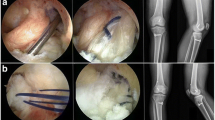Abstract
Purpose
Various histological and immunological methods have been used to detect the mechanoreceptors and nerve fibers on the intact ACLs as well as on the remnant stumps. However, some of these methods lack standardization, and the variable thickness of slices used often leads to misinterpretation. The study was based on the hypothesis that immunohistological methods are easier and more reliable means to demonstrate mechanoreceptors in the remnant ACL stumps as compared with the conventional methods. We also attempted to validate the methodology of immunohistology as a means of characterizing functional mechanoreceptors in the residual stump of an injured ACL.
Methods
The remnants of the ruptured ACL in 95 patients were harvested during arthroscopic ACL reconstruction and evaluated immunohistologically using hematoxylin and eosin (H&E), and monoclonal antibodies to S-100 and NFP. Multiple sections from each specimen were serially examined by two histologists.
Results
The positivity of monoclonal antibody against NFP showed a statistically significant relationship with the presence of morphologically normal mechanoreceptors, whereas the positivity of monoclonal antibody against S-100 showed a statistically significant relationship with the presence of free nerve ending in the residual stump of an injured ACL.
Conclusions
Immunological methods are more reliable and easier to use as compared with the conventional methods of histological staining for identifying remnant stumps likely to be of some proprioceptive benefit after an ACL injury. Such an identification might help us preserve certain remnant stumps during ACL reconstruction which might in turn improve the postoperative functional outcomes.



Similar content being viewed by others
References
Adachi N, Ochi M, Uchio Y, Iwasa J, Ryoke K, Kuriwaka M (2002) Mechanoreceptors in the anterior cruciate ligament contribute to the joint position sense. Acta Orthop Scand 73:330–334
Adachi N, Ochi M, Uchio Y, Sumen Y (2000) Anterior cruciate ligament augmentation under arthroscopy. A minimum 2-year follow-up in 40 patients. Arch Orthop Trauma Surg 120:128–133
Barrett DS (1991) Proprioception and function after anterior cruciate ligament reconstruction. J Bone Joint Surg Br 73:833–837
Biedert RM, Stauffer E, Friederich NF (1992) Occurrence of free nerve endings in the soft tissue of the knee joint. A histologic investigation. Am J Sports Med 20:430–433
Borsa PA, Lephart SM, Irrgang JJ, Safran MR, Fu FH (1997) The effects of joint position and direction of joint motion on proprioceptive sensibility in anterior cruciate ligament—deficient athletes. Am J Sports Med 25:336–340
Del Valle ME, Harwin SF, Maestro A et al (1998) Immunohistochemical analysis of mechanoreceptors in the human posterior cruciate ligament: a demonstration of its proprioceptive role and clinical relevance. J Arthroplasty 13:916–922
Denti M, Monteleone M, Berardi A, Panni AS (1994) Anterior cruciate ligament mechanoreceptors. Clin Orthop Relat Res 308:29–32
Dhillon MS, Bali K, Vasistha RK (2010) Immunohistological evaluation of the proprioceptive potential of the residual stump of an injured anterior cruciate ligament. Int Orthop 34:737–741
Georgoulis AD, Pappa L, Moebius U et al (2001) The presence of proprioceptive mechanoreceptors in the remnants of ruptured ACL as possible source of reinnervation of ACL autograft. Knee Surg Sports Traumatol Arthrosc 9:364–368
Halata Z, Rettig T, Schulze W (1985) The ultrastructure of sensory nerve endings in human knee joint capsule. Anat. Embryol(Berl) 172:265–275
Hogervorst T, Brand RA (1998) Mechanoreceptors in joint function. J Bone Joint Surg Am 80:1365–1378
Johansson H, Sjolander P, Sojka P (1991) A sensory role for the cruciate ligaments. Clin Orthop Relat Res 268:161–178
Johansson H, Sjolander P, Sojka P (1991) Receptors in knee joint and their role in biomechanics of joint. Crit Rev Biomed Eng 18:341–368
Kennedy JC, Alexander IJ, Hayes KC (1982) Nerve supply of the human knee and its functional importance. Am J Sports Med 10:329–335
Krauspe R, Schmidt M, Schaible HG (1992) Sensory innervation of the anterior cruciate ligament. An electrophysiological study of the response properties of single identified mechanoreceptors in the cat. J Bone Joint Surg Am 74:390–397
Krauspe R, Schmitz F, Zöller G, Drenckhahn D (1995) Distribution of neurofilament-positive nerve fibres and sensory endings in the human anterior cruciate ligament. Arch Orthop Trauma Surg 114:194–198
Lee BI, Kwon SW, Kim JB et al (2008) Comparison of clinical results according to amount of preserved remnant in arthroscopic anterior cruciate ligament reconstruction using quadrupled hamstring graft. Arthroscopy 24:560–568
Lee BI, Min KD, Choi HS et al (2009) Immunohistochemical study of mechanoreceptors in the tibial remnant of the ruptured anterior cruciate ligament in human knees. Knee Surg Sports Traumatol Arthrosc 17:1095–1101
Ochi M, Adachi N, Deie M, Kanaya A (2006) Anterior cruciate ligament augmentation procedure with a 1-incision technique: anteromedial bundle or posterolateral bundle reconstruction. Arthroscopy 22:463.e1–5
Schultz RA, Miller DC, Kerr CS, Micheli L (1984) Mechanoreceptors in human cruciate ligaments. A histological study. J Bone Joint Surg Am 66:1072–1076
Schutte MJ, Dabezies EJ, Zimny ML, Happel LT (1987) Neural anatomy of the human anterior cruciate ligament. J Bone Joint Surg Am 69:243–247
Shimizu T, Takahashi T, Wada Y et al (1999) Regeneration process of mechanoreceptors in the reconstructed anterior cruciate ligament. Arch Orthop Trauma Surg 119:405–409
Zimny ML, Schutte M, Dabezies E (1986) Mechanoreceptors in the human anterior cruciate ligament. Anat Rec 214:204–209
Conflict of interests
The authors declare that they have no competing interests.
Author information
Authors and Affiliations
Corresponding author
Rights and permissions
About this article
Cite this article
Bali, K., Dhillon, M.S., Vasistha, R.K. et al. Efficacy of immunohistological methods in detecting functionally viable mechanoreceptors in the remnant stumps of injured anterior cruciate ligaments and its clinical importance. Knee Surg Sports Traumatol Arthrosc 20, 75–80 (2012). https://doi.org/10.1007/s00167-011-1526-9
Received:
Accepted:
Published:
Issue Date:
DOI: https://doi.org/10.1007/s00167-011-1526-9




